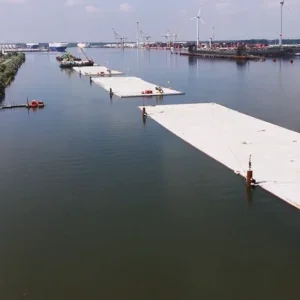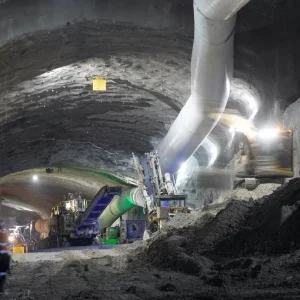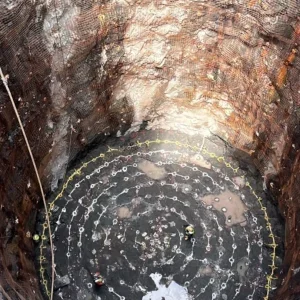There is currently an emerging demand for deep shaft accesses, for water schemes such as Thames Tideway, coal extraction (although not in this country in any great quantity) and metaliferous mining for gold, tin, copper and others as well as mineral extraction, in particular salt and potash.
In addition to these varying industries there is the long running government mandate requiring the development of undergound nuclear waste storage facilities to be fully functional by 2040.
These demands are ensuring that the design and development of deep shafts is becoming and ever increasingly important issue.
Deep shafts can be categorised into two types:
The deep civil engineering shafts (up to 50m in diameter and down to depths of about 70m) and mine shafts (Up to 10m in diameter and down to depths of more than 3000m).
The background that supports the distinction between these two groups is the Approved Code of Practice on the Mines (Shafts and Winding) Regulations 1993 under Section 16 of the Health and Safety at Work etc Act 1974 and New Brunswick Regulation 96 – 105 under the Occupational Health and Safety Act (O.C. 96 – 968). Bothof these documents define limits for the maximum depth of shaft that a crane can be used. At greater depths the shaft must have a head-frame and winding gear.
This paper will focus on mine shafts and the associated design and construction practices.
UK shaft sinking
The present state of the UK’s deep shaft sinking capability is a subject of concern. Table 1 gives historical data relating to this subject. In contrast Table 2 reveals the stark reality of the state of the industry with the summary of shafts sunk from 1987 onwards.
The two major UK shaft sinking companies who have completed these works in the past, Cementation Mining and Thyssen (GB), no longer exist. This leaves Amalgamated Construction Company (Amco) as the only current company to have sunk a deep shaft from the surface in the UK and that was only one shaft 27 years ago.
Most of the contractors’ personnel with the specialist shaft sinking knowledge have disappeared from the industry. All of the contractors’ specialist shaft sinking equipment, which they used to retain, including head-frames, scaffolds (in shaft working platforms) and winders have been scrapped. A major shaft sinking learning curve will be required in the future for any UK company to take on the construction of deep mine shafts in the UK. This is particularly relevant for the future construction of an underground nuclear waste repository.
Global shaft sinking
The construction of deep shafts is progressing and flourishing around the world with ever increasing commodity prices making previously uneconomic deep reserves commercially viable. This increases the need for ever deeper shafts. The locations and numbers are too numerous to list but a broad brush example of some of these projects in which the Alan Auld Group is associated are:
In Canada
• Potash Corporation of Saskatchewan (PCS) Piccadilly Potash Mine Project, New Brunswick. Two shafts 5.5m diameter, 920m deep are presently under construction – groundwater control by grouting.
• PCS Scissor’s Creek (Rocanville West) Potash Mine Project, Saskatchewan. One shaft 6.0m diameter, 1,130m deep under construction – groundwater control by freezing to 600m, grouting below.
• BHP Billiton Diamonds Jansen Potash Mine Project, Saskatoon, Saskatchewan. Two shafts 6.5m diameter, 1,135m deep out to tender – groundwater control by freezing to 525m, grouting below.
• Saskatchewan. Two shafts 6.0m diameter, 962m deep at pre-feasibility stage – groundwater control by freezing to about 500m, grouting below.
In the Russian Federation and Kazakhstan
• Eurochem – Volgakaliy Gremyachinsky Potash Mine Complex, near the town of Kotelnikovo in the Volgograd Region. One shaft 7.0m diameter, 1000m deep under construction – groundwater control by grouting.
In Ukraine
• Lubel Coal Company Lubelska No.1 and No. 2 Coal Mine Project in North West Ukraine. Two shafts 8m, 980m deep at feasibility stage – groundwater control by grouting.
Design
The geological and hydrological data for the ground are the key factors in shaft design. A shaft centerline borehole is drilled to give an understanding of the conditions. Work that will take place will include borehole logging, core logging, hydrological testing (water flow is a critical parameter in the design of the shaft lining and subsequent sinking operations) and lab testing of retrieved samples. Analysis of this data and information recorded during the drilling of the borehole (drill mud loss indicates zones of fracturing) will all build to form a model for the ground in which the shaft will be constructed and the associated measure to be adopted for sinking activities and the long term stability of the shaft structure. This pre-engineering requires constant re- confirmation during shaft excavation.
Once the necessary information has been gathered, development of the shaft lining design can progress. There are three basic types of shaft lining:
• Concrete Lining. Some of the key features of this solution are: it is hydrostatic pressure resisting, provides a dry shaft with acceptable residual water make < 23l/min (considered dry) over it’s full depth, requires competent (self standing when excavated) rock lining and installed from the top downwards as sinking proceeds.
• Composite concrete and steel lining: Where greater pressures are likely to be encountered a composite concrete and steel lining might be a more suitable solution. This lining would be both hydrostatic and geostatic pressure resistant as well as 100 per cent watertight. Suitable for competent rock or unstable ground (sands, silts and clays frozen for stability). The drawback of this system is that the permanent lining cannot be built top down. The lining is installed upwards from a foundation after sinking downwards using temporary support.
• Tubbing lining: Spheroidal graphite cast iron or fabricated steel bolted segments are a hydrostatic/geostatic pressure resisting lining that provide a dry shaft. They can be installed quickly in difficult ground conditions as sinking proceeds downwards. Sealing is achieved using lead gaskets, PVC gaskets or lead caulking.
Construction
A key factor during the construction of the shaft is access and the work staging or scaffold. As the shaft sinks, everything is required to advance with the face. The scaffold carries all necessary equipment except for the muck skip or hoppit and a drill jumbo if it should be required for drill and blast excavation.
All of the necessary pit top infrastructure is established once the shaft is of sufficient depth to house the scaffold. This will include the headframe and winding gear, muck handling system and ventilation as well as any requirements for ground freezing.
The winding gear arrangement will incorporate a number of hoisting systems for the staging or scaffolding and muck hoisting.
The conventional hard rock methodology for excavation is by drill and blast. Drilling for blast holes utilizes multi boom drill jumbos been used around the world. Examples include oil industry drill rigs with over sized drill heads, raise borers and “V” moles which adopt a pilot hole drilled from the surface to existing underground workings where the cutting head is attached and pulled back to surface to create the shaft, the cut material falls back to the base of the shaft for removal. Of greater interest to the tunnelling industry are vertical tunnelling machines.
Examples of these are the Robbins 241SB-184 blind shaft borer developed between 1975 and 1983 operated by Cementation America and used in Oak Grove, Alabama. The machine has a 7.4m diameter and was used to excavate almost 180m of the shaft. It achieved a daily advance of 4.8m against a target of 7.6m. The main issue was the removal of excavated material from the face. The machine adopted a system of chain conveyors and buckets to lift the material from the bottom of the shaft up to the muck hoppit for transfer to surface.
In 1983/85, Redpath and Robbins developed an alternative machine utilising a rotating disc cutting head with a clamshell grab to remove spoil from the face. Although built, the machine was never actually used.
Ground stability and water control methods
As shaft excavation progresses, the ground conditions and water ingress are critical issues to the stability and safety of the workings. The pre-construction investigation works should have determined the level at which water will be encountered but during the sinking of the shaft regular boreholes should be completed to confirm the expected conditions.
Encountering water is inevitable. If the quantities are low (below 23l/min) then a pumping system can be installed to deal with the inflow, any greater amounts will warrant the adoption of a method of ingress control. This could be either grouting from surface, cover grouting from within the shaft or ground freezing.
The grouting from surface and the cover grouting adopt a pattern of drill holes around the perimeter of the shaft into which a suitable grout is pumped. The intention is for the grout to permeate the ground between the holes creating a barrier to the water path. The cover grouting will occur along the length of the shaft as and when ground conditions and water dictate. Under certain circumstances the drill pattern will incorporate a cut-off layer beneath the shaft to prevent ingress from below.
Ground freezing techniques adopt identical logic but cold brine is circulated through pipes installed into the drill holes which results in a frozen zone around each hole and subsequently the entire shaft preventing the flow of water into the shaft.
Lining techniques
Placement of the structural concrete lining adopts relatively common shuttering systems but with particular features to permit the lining to be placed below the previous pour not above as in standard casting operations. The joint detail is designed to permit placement of concrete into a bay below the previous one. Standard pours are 6m lifts with the shuttering suspended from the previous bay, a kerb ring and the bottom of the lift acts as the stop end at the underside of the pour. The mix design and rate of pour are selected to ensure that only half of the pour loads are ever taken by the previous pour through hanging rods. All other loads are transferred into the surrounding ground.
Each lift will then undergo back wall grouting to seal the bay and instead of a water bar, a high pressure grout hose is installed to enable the joints to be sealed from water ingress at the extreme depths and associated water pressures.
For the combined lining, the temporary lining will be installed, next the steel liner will be placed with fully welded joints between the lining rings before the final concrete lining is slip formed. The segmentally (tubbing) lined shafts are constructed in a very similar manner to the underpinning method.
Table 1 comparing shafts built before 1987 Table 2 comparing shafts built after 1987 Sinking scaffold being lowered into shaft at Selby coalmine complex Chinese six boom jumbo drill Chinese catcus grab. Redpath/Robbins shaft boring machine







